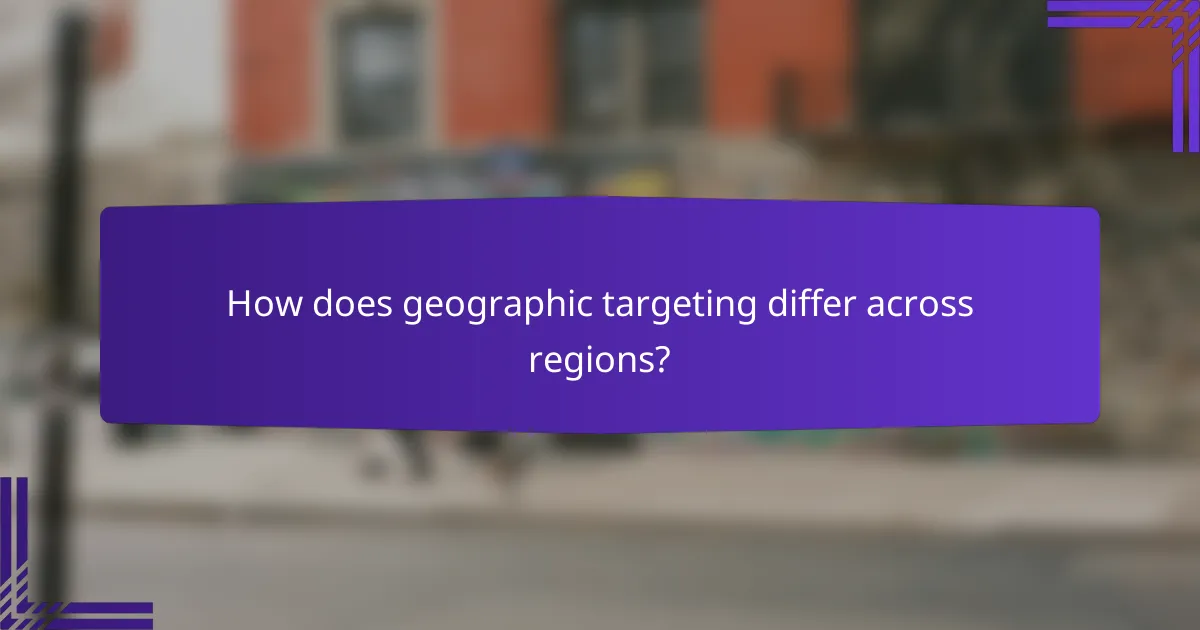Geographic targeting is a powerful strategy in display advertising that focuses on reaching specific audiences based on their location. By tailoring messages and offers to local preferences and behaviors, businesses can enhance engagement and improve conversion rates, ultimately leading to better overall performance metrics.

What are effective geographic targeting strategies for display advertising?
Effective geographic targeting strategies for display advertising focus on reaching specific audiences based on their location. By utilizing various techniques, advertisers can enhance engagement and conversion rates by delivering relevant ads tailored to local preferences and behaviors.
Location-based audience segmentation
Location-based audience segmentation involves dividing your target market into groups based on geographic criteria such as country, region, or city. This allows advertisers to tailor their messaging to resonate with local cultures and preferences, improving the relevance of their ads.
For example, a restaurant chain may create different ads for urban and rural locations, highlighting unique menu items that appeal to each demographic. Using tools like Google Ads, advertisers can easily set up campaigns targeting specific locations.
Geo-fencing for local promotions
Geo-fencing is a technique that creates a virtual boundary around a specific location, triggering ads when users enter that area. This strategy is particularly effective for local promotions, as it allows businesses to reach potential customers in real-time.
For instance, a retail store could send special offers to smartphones within a 1-mile radius, encouraging immediate visits. It’s essential to ensure that the offers are compelling enough to motivate foot traffic while respecting user privacy and consent.
Dynamic ad content based on user location
Dynamic ad content adjusts the messaging and visuals of an advertisement based on the user’s geographic location. This personalization can significantly enhance user engagement by providing relevant information that resonates with the local audience.
For example, an online travel agency might display different vacation packages depending on whether the user is searching from New York or Los Angeles. Implementing dynamic content requires robust data management and creative capabilities to ensure timely and accurate updates.
Utilizing IP address targeting
IP address targeting allows advertisers to deliver ads based on the geographic location associated with a user’s IP address. This method can be effective for targeting users at a more granular level, such as specific neighborhoods or regions.
However, it is crucial to consider the accuracy of IP data, as users may be traveling or using VPNs, which can lead to mismatched targeting. Combining IP targeting with other methods can help improve precision and effectiveness.
Leveraging local SEO practices
Integrating local SEO practices into your advertising strategy enhances visibility in local search results, driving organic traffic to your website. This involves optimizing your content for local keywords, creating location-specific landing pages, and ensuring your business information is accurate across online directories.
For example, a local bakery should include keywords like “best pastries in [City Name]” on their website. Additionally, claiming and optimizing a Google My Business listing can significantly improve local search rankings and attract nearby customers.

What benefits does geographic targeting provide?
Geographic targeting enhances marketing efforts by allowing businesses to tailor their messages and offers based on the location of their audience. This approach leads to more relevant advertising, improved engagement, and ultimately better performance metrics.
Improved ad relevance and engagement
Geographic targeting ensures that ads are shown to users in specific locations, making them more relevant to the audience’s context. For instance, a local restaurant can promote a special offer to nearby residents, increasing the likelihood of engagement. This localized approach resonates better with potential customers, leading to higher interaction rates.
By focusing on specific regions, businesses can also adjust their messaging to reflect local culture, preferences, and needs, further enhancing engagement. This tailored communication fosters a sense of connection between the brand and the consumer.
Higher conversion rates
When ads are relevant to the audience’s location, conversion rates tend to increase significantly. Users are more likely to act on offers that are pertinent to their immediate environment, such as local sales or events. For example, a clothing store promoting a seasonal sale to nearby shoppers can see a notable uptick in foot traffic and online orders.
Additionally, geographic targeting allows businesses to optimize their sales funnels by directing users to location-specific landing pages, which can improve user experience and drive conversions effectively.
Cost efficiency in ad spend
Geographic targeting can lead to more efficient ad spending by reducing wasted impressions on users who are unlikely to convert. By focusing on specific areas, businesses can allocate their budgets more effectively, ensuring that funds are spent on audiences with a higher likelihood of engagement. This targeted approach can result in lower cost-per-click (CPC) and higher return on investment (ROI).
For instance, a company running a campaign in multiple regions can analyze performance data to identify the most profitable locations and adjust their budget accordingly, maximizing their advertising impact.
Enhanced customer insights
Implementing geographic targeting provides valuable data on customer behavior and preferences within different regions. Businesses can analyze which locations yield the best performance and tailor their strategies accordingly. This insight can inform future campaigns, product offerings, and even store locations.
Moreover, understanding regional trends allows companies to adapt their marketing strategies to meet local demands, ensuring they remain competitive in various markets. Regularly reviewing geographic performance metrics can help businesses stay ahead of changing consumer preferences.

How can geographic targeting enhance advertising performance?
Geographic targeting can significantly improve advertising performance by ensuring that marketing messages reach the right audience in specific locations. This strategy allows advertisers to tailor their campaigns based on local preferences, behaviors, and demographics, leading to higher engagement and conversion rates.
Real-time performance tracking
Real-time performance tracking enables advertisers to monitor how their campaigns are performing in different geographic areas. By analyzing metrics such as click-through rates and conversion rates by location, businesses can quickly identify which regions are performing well and which are not.
Utilizing tools like Google Analytics or specialized geo-targeting software can provide insights into user interactions. This data allows for immediate adjustments to campaigns, optimizing ad spend and maximizing return on investment.
Optimizing campaigns based on location data
Optimizing campaigns based on location data involves adjusting ad content, timing, and budget according to the specific characteristics of each target area. For instance, a restaurant chain might promote lunch specials in urban areas during weekdays while focusing on family deals in suburban locations during weekends.
Consider using A/B testing to compare different ad versions tailored to specific regions. This approach helps determine which messages resonate best with local audiences, allowing for more effective allocation of resources.
Personalized user experiences
Personalized user experiences can be achieved by leveraging geographic targeting to deliver relevant content to users based on their location. For example, e-commerce platforms can show products that are popular in a user’s area or offer local promotions to entice purchases.
Incorporating local language, cultural references, and regional events into advertising can enhance user engagement. Additionally, using location-based services can provide timely notifications about nearby sales or events, further increasing the likelihood of conversions.

What criteria should be considered for geographic targeting?
When implementing geographic targeting, consider factors such as location demographics, cultural preferences, and local market conditions. These criteria help tailor marketing strategies to specific regions, enhancing relevance and effectiveness.
Demographic data analysis
Demographic data analysis involves examining population characteristics such as age, gender, income, and education levels within a targeted area. This information allows businesses to identify their ideal customer profiles and tailor their messaging accordingly.
For example, a luxury brand may focus on affluent neighborhoods, while a budget retailer might target areas with lower average incomes. Analyzing demographic trends can also reveal shifts in population that may affect market potential.
Market research and competitor analysis
Market research provides insights into consumer behavior, preferences, and trends within specific geographic areas. This research can include surveys, focus groups, and analysis of local buying patterns, which help identify opportunities and challenges in the market.
Competitor analysis complements market research by evaluating the strengths and weaknesses of other businesses in the area. Understanding competitors’ strategies can inform your own approach, helping to differentiate your offerings and capture market share effectively.

How does geographic targeting differ across regions?
Geographic targeting varies significantly across regions due to differences in demographics, cultural values, and economic conditions. Understanding these variations is crucial for tailoring marketing strategies that resonate with local audiences.
Urban vs. rural targeting strategies
Urban targeting strategies often focus on convenience and lifestyle, highlighting products and services that cater to fast-paced living. Advertisements may emphasize quick delivery options, trendy items, and local events that appeal to city dwellers.
In contrast, rural targeting strategies typically prioritize practicality and community values. Marketing efforts may highlight durability, affordability, and local heritage, often using imagery that resonates with outdoor lifestyles and family-oriented messaging.
Cultural considerations in ad messaging
Cultural considerations are vital in shaping ad messaging to ensure relevance and respect for local customs. For instance, colors, symbols, and language can carry different meanings across cultures, influencing how a message is received.
Marketers should conduct thorough research to understand cultural nuances, avoiding stereotypes and ensuring that messaging aligns with local values. Engaging local influencers can also enhance credibility and foster a deeper connection with the target audience.
